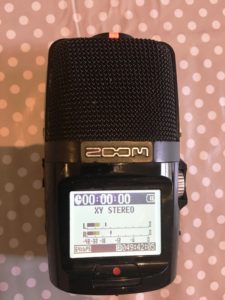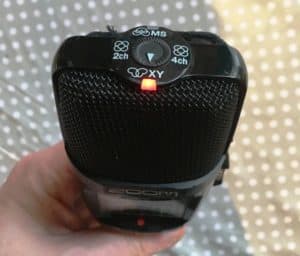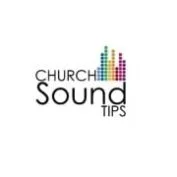The Zoom H2n Portable Recorder is what I use most of the time for recording sermons, recording music and doing podcasts. I am also a musician and use it for recording practise sessions. One of the big benefits for me in using a portable digital recorder like this one is that because I do sound for a multisite church, it is so quick and easy to use and set up when going between venues.
Churchsoundtips.com is a participant in the Amazon Services LLC Associates Program. As an Amazon Associate Churchsoundtips.com earns from qualifying purchases.
The H2n is a great tool to have for recording if you host special events, conferences, seminars, surround sound recordings for live music or concerts, or even as part of your outreach, maybe doing vox pops. It is simple to use, and has built in microphones so you don’t need to set up mics separately. Also if you do offsite video, The H2n a great audio recorder to work along with a video camera as it has a mid side recording mode. You can get an adapter for it so that it can be secured on a standard mic stand or you can use a small screw-in mini tripod to stand it on a desk.
The H2n is a very high quality podcasting mic for the money. I used to own the previous version, the H2, which was a trusty workhorse until I stupidly dropped it on a hard floor and broke. Knowing the high quality of the recording from these devices, I didn’t hesitate getting another one, but this time went for the upgraded Zoom H2n handy recorder. The H2n is not quite as robust as it’s bigger brothers the H4n or H6, which do surround sound recordings, but still a good machine for the money. In this Zoom H2n review, I hope to highlight in this the pro and cons and why I like this audio recorder so much and for it’s great sound quality. Overall it’s one of the best portable recorders I have used.
Key Features

Recording formats
With the Zoom H2n, portable recorder you can record direct to WAV or MP3 formats at various bitrates. #ad For WAV format you can record up to 24 bit and 96Khz/sec and with MP3 up to 320kbps and as low as 48kbps. The data rate you use for recording will very much determine how much memory you use up, which is stored on a removable SD card. I find that for MP3 speech recording on the H2n microphone, anywhere between 64 and 96kbps is sufficient and keeps file sizes down for transferring sermons to podcast hosting. For music recording to MP3 I wouldn’t use less than 192kbps.
You can listen to a couple of samples I have recorded on the H2n portable recorder. The 1st is speech at 96kbps with the microphone held about 1 foot from my mouth and the second is an acoustic guitar at 48KHz/24bit again between 1-2 feet away. It will give you some idea of what it sounds like, but the H2n recorder is obviously capable of a lot more than this. The H2n frequency response is equally very good for music or speech.
Sound Quality Samples
The Zoom H2n field recorder compares well with other models in its price range and is fairly easy to use. #ad The menu system user interface is accessed via a menu button on the side and then using a play button which moves up and down to make menu selections(which you can see in the picture below). The screen on the H2n is LCD but has a backlight for working in darker conditions. If you have the monitor switched on, it displays the current recording level and how much recording time you have left of the SD for the current recording mode. It also displays a timer which starts when you press record so you know how long you have been recording for. The H2n is powered by 2 AA batteries, which will tend to last me about 3/4 weeks of regular use and the LCD display shows you the current battery level. To record, there is a large record button just underneath the LCD screen. You press it once and a red recording light appears on the front of the unit. You use the same button on the H2n to stop recordings.

Beside the menu button on the H2n portable recorder, you have your power on button, a mic gain control and a hold button which locks the settings so that you don’t stop recording by accident. Very useful! Because I tend to use the Zoom H2n for only a couple of application, I don’t touch the mic gain knob very often.
On the other side of the H2n has a 1/8″ mini jack socket for mic input and a line input. This could be used for example if you have another microphone like a lapel mic or lavalier mic, but you want the ability to record using the H2n, you could plug the other mic into the mini jack. There is a volume control as the unit has a built-in speaker, so you can check your recordings straight away. It’s helpful if you are going through old files and you want to check what they are before deleting them. You may be able to see in the photograph below, a remote socket, which is for the handy recorder remote for this unit which you can get with the official accessories pack. There is also a headphone output you could use for monitoring or listening back to a recording as the built in loudspeaker ins’t very loud.
There is a micro USB port socket on the Zoom H2n for using the microphone as a plug in USB microphone which you can plug straight into a computer and have the ability to record from the PC or laptop, effectively using is as an audio interface. This is useful if you want to use it for live video streaming or podcasting. If you do plan to do a Zoom H2n podcast, I would recommend getting the version that comes with the accessories pack because you get the remote control, a windscreen, padded case, USB 2.0 cable, microphone clip adapter, mini tripod stand. It can also be used as a shotgun mic, good for filming video. With the USB socket, it effectively allows you to use the mic as an audio interface, albeit limited to to this mic.
Click here to Check Price. #ad
Mic modes
The H2n USB mic is very versatile in that it has four different recording modes with x y stereo, mid side and 4 channel surround sound recording, which can be set using the selector switch on the top of the field recorder as I have shown in the photo below. The Zoom H2n is a surround sound portable recorder and has 5 built in mic capsules and the rotating selector on the top allows you to choose various combinations of these mic capsules. The X Y setting is for stereo recording from the mic capsules at the front of the device. The M S mode setting is for mid-side recording, very useful for video production and film recording where you might want to later adjust the width of the stereo image. The mid side mode make this device very popular with film makers. Overall the H2n microphone in x y mode produces a very good stereo field recording. The 2ch setting is for 2 channel surround recording, which combines the signal from the combined mics into a single stereo file.
The 4ch modes setting on the Zoom H2 is for the ability to record 4 channel surround sound where the X Y and MS mid side audio is stored in separate files. The advantage of this is that the two audio signals can be routed to different speakers to give a truly surround sound experience. With the increasing popularity of VR, at least at the time of writing, the H2n is the only portable recorder I know of that enable you to do spacial audio for VR and 360 degree surround sound videos. The 4 channel mic mode allows you to do this quite easily and works well with the Google Jump VR platform.

Menus
Folder
When you press the menu button on the handy recorder you are presented with 6 sub menus – Folder, File, Input, Rec, Tool and System. I’ll take each submenu one by one and try and explain what they do. Under Folder, you can select the various folders on the memory card which will deternine which location your sound recording files will be saved to.
File
Then you have the File selector, which allows you to select any digital audio file on the H2n within the previously selected Folder. After choosing a file, there are a number of other options presented, Information which tells you the date of recording and file format and size of file; Rename allows you to rename the files on the memory card, MP3 Encode enable you to select the MP3 bitrate for a file. Obviously, you cannot convert from a lower rate to higher rate, but from within the menu you can convert an MP3 file to a lower bit rate file; Normalize allow you to use a normalize function usually found in DAW software, which brings peaks up to -3dB. Lastly within the File submenu, you have a Divide option to split a track by selecting time from beginning/end.
Input
Under the Input menu on the Zoom H2 you have 5 options. Lo Cut, allows you to switch the low cut filter on or off; Comp/Limiter has 3 different Compressor limiter settings for general, vocal and drums or you can choose a limiter setting for general, concert or studio. There is also a Monitor submenu, which allows the monitor to always be on or off, or there is the option of enabling the monitor by pressing home button first and record. Lastly, there is an Auto Gain (AGC) function with option, Off, Concert, Solo and Meeting. I’m not a fan of using auto gain on the H2n field recorder as it can add a lot of hiss during quiet periods. But then the auto gain could be usesul in certain situations, such as a meeting with various people speaking at different volume levels, and you could get rid of the hiss in post processing.
Record
Under the Rec menu there are 5 submenus; Rec Format allows you to select recording format, along with the corresponding bit rate/frequency; Auto Rec is an automatic recording mode function where you can set the recording start and stop levels; Pre Rec is a pre-record function which can be set either to on or off. This is really useful as it keeps the Zoom H2n constantly recording on a loop in the background, so that when you hit record, if you are a few seconds too late, it will store the audio that you might have missed. Filename submenu allows you to choose file name format by date etc. For recording church services and sermons, it delivers great audio quality and without needing a complicated set up.
Tool
The Zoom H2n #ad doesn’t really have any special audio effects, however is does have two very helpful built in tools, an instrument tuner and a metronome; selecting Tuner opens up another submenu of functions; Calibration allows you to calibrate the tuner to a particular frequency; Chromatic opens up a chromatic tuner with a visual ‘meter type’ display; Guitar selects the built-in guitar tuner with meter display and Bass option is very similar except for Bass Guitar. There are tuning options for Open A, Open D, Open E, Open G and DADGAD. A very useful addition to the Zoom H2n. Under the Metronome submenu, there are 6 options; Click allows you to set device as a metronome only, or recorder only or both; Pre-Count will play a pre-defined number of click to lead into 1st bar of song; Temp allows the user to set the tempo of the metronome; Sound allows you to choose from a number of different sounds, Bell, Click, Tick, Cowbell or High-Q; Pattern submenu allows you to select the time signature 0/4, 1/4, 2/4, 3/4, 4/4, 5/4, 6/4, 7/4, 8/4, 6/8. Level enables you to select the Metronome volume level.
System and Firmware
Under the Zoom H2n recorder System menu there are 6 selections, Date/Time settings, Back light on/off, Display Contrast, Battery, Software/Firmware info and Factory Reset option.
SD Card and USB Interface
The final option on the main menu relates to the SD Card lsot, with two menu items; Remain which displays the remaining storage space; and Format which allows you to format the card. With the H2n USB interface, the field recorder can also be used as a card reader, allowing you to read directly from the memory card. All you need to do is plug in the usb cable into a computer and you can read the contents of the SD card as an external drive.
Recording length
The Zoom H2 comes with a 2GB SD card as standard, but depending on what you are using it for, you may find that this isn’t nearly enough. It supports SDHC format but I would advise having at least two SDHC cards, where you always have one in the Zoom H2n recording mic for immediate use, and perhaps another one you can remove to upload files to laptop or PC. I find doing it this way much better than connecting via a USB cable.
To give you an idea of what size card you might need, see the table below.
[one-third-first]Stereo mode MP3 320kbps WAV 24bit/96kHz[/one-third-first] [one-third]2GB 13 hours of recording time 57 min [/one-third] [one-third]16GB 151hrs 7hrs [/one-third] [one-third-first]4 channel mode WAV 24 bit/48kHz [/one-third-first] [one-third]2GB 57 min[/one-third] [one-third]16GB 7hrs[/one-third]The Sandisk 16GB SDHC card 2-pack is ideal for this and is available on Amazon. Click here to get the current price of the H2n and remember to add your SD cards too. I believe it will also accept a 32GB SD card for even longer recording time. #ad
Battery life
Other consideration is what the battery life is like for the Zoom H2n recorder. It uses x2 AA batteries, which in my experience last quite a long time. I usually record for 30–40 minutes at a time and, the alkaline batteries usually have a battery life that lasts for about 4-5 recording sessions. I have tried it with rechargeable batteries too, but how long they last varies greatly with the quality of the batteries used. I have found regular batteries to last longer than rechargeables on a single charge.
Accessory Pack
If you are checking out this recording device on Amazon, be aware that there are some deals available that include an accessory pack, usually with a windscreen or dead cat, and sometimes a tripod.
FAQs
Is the Zoom H2n any good for Podcasting?
The Zoom H2n would make a great podcasting microphone, in fact I use it for this very purpose, as well as for recording audio for Youtube video. It is an excellent microphone for recording the spoken word, which makes it ideally suited for podcasting. Also because it’s portable, it means you can do you podcast or do field recordings from any location.
Is The Zoom H2n any good for recording guitar?
Yes, it is an excellent device for recording guitar. For acoustic guitar, you can use stereo mode and place within 1-2 feet of the sound hole for good results. Alternatively, if you want a sense or room ambiance, you can use 4 channel recording.
Can you the H2n to record drums?
Yes your can, but it depend what your aim is. If you want an accurate representation of the drums to record a song, and later edit sound levels for individual drums and cymbals, then no, this is probably not the right mic to use. However if you just want a live feel to your recording, then yes, you could use this recorder for that purpose.
Conclusions
The Zoom H2n USB microphone has so many more advanced features that may or may not be applicable depending on what you want to use it for, such as built-in compression and filtering, variable playback speed, 2ch stereo and 4ch recording modes, and ms mid side decoding. This recording comes standard with a license for Steinberg Cubase LE software and Wavelab LE for editing etc. It has been one of the best pieces of kit I have bought over the past few years and has never let me down. Highly recommended all round. There are stereo recorders a out there that are cheaper, but the H2n has just the right balance on price and recording quality.
For more info from the manufacturer:
https://zoomcorp.com/en/us/handheld-recorders/handheld-recorders/h2n-handy-recorder/

Leave a Reply